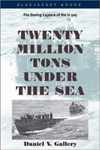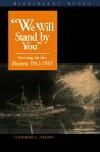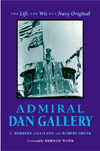Twenty Million Tons under the Sea
Gallery, Daniel V., RAdm., USN, ret.
2001, United States Naval Inst.
ISBN 1557508062
Hardcover, 344 pages
| Type. | General History |
| Pros. | Entertaining and well-researched |
| Cons. | Facts are "improved upon" in a few places; language can be a bit difficult (see below) |
| Rating. |  |
 Written in 1956 by the man responsible for the capture of U-505 and her decades-long afterlife as an exhibit in the Museum of Science and Industry in Chicago, this book combines an outline of the Battle of the Atlantic and the career histories of U-505 and USS Guadalcanal into a thoughtful yet accessible and often humorous narrative.
Written in 1956 by the man responsible for the capture of U-505 and her decades-long afterlife as an exhibit in the Museum of Science and Industry in Chicago, this book combines an outline of the Battle of the Atlantic and the career histories of U-505 and USS Guadalcanal into a thoughtful yet accessible and often humorous narrative.
Based on interviews with surviving crews, a thorough reading of war diaries, and his postwar correspondence with her two surviving commanders, Gallery presents the complete operational history of U-505 from the laying down of her keel to her capture four years later, as well as some incidents in the life of U-515, notably the torpedoing of the Ceramic and the sinking of the U-boat and capture of her crew and commander (Henke). The operations of the Guadalcanal from commissioning onward, including the revolutionary use of night-flying and the sinking of U-68, are also covered in detail. An early chapter describes base life in Iceland in early 1942, and recounts the saga of Convoy PQ-17 as well as the capture of U-570.
Gallery helpfully places various key dates in the life of U-505 in the context of events occurring simultaneously in the land war, and provides an overview of the highlights of the U-boat war (Scapa Flow, the Night of the Long Knives) as well as its setbacks (the loss of Prien and Schepke and the capture of Kretschmer) which occurred before U-505's entry into active service. He graphically illustrates the ebb and flow of control of the seas over the course of the war by noting the changes in the "exchange rate" of U-boats lost to shipping lost, and in the number of hours U-boats were able to travel surfaced versus submerged. One chapter provides an excellent background on U-boat design and technology, reducing complicated technical concepts to simple language for the layman.
While the book is well-researched and generally quite accurate (with the exception of some misspellings of German terms, and referring to Heinz-Wilhelm Eck as "EMS"), it should be mentioned that the author approached some of the smaller details with a degree of poetic license. By all accounts, Admiral Gallery was a good storyteller, and was not averse to embroidering the facts a bit here and there if he felt that doing so would improve the tale. He provides some warning in his prologue by noting that he obviously had no way of knowing whether the conversations between crewmembers on board U-505 actually occurred exactly as he presents them. There are also a few other places in the book where he presents as fact what he could not have known (e.g., the detailed private thoughts of Zschech and Henke). In particular in the chapter dealing with Zschech's suicide, Gallery alters a few facts and invents a few incidents to further dramatize this already dramatic event.
But it could be argued that, in most cases, Gallery was simply exercising his insight into human nature, shown to good effect in his analysis of the contrasting personalities of the three commanders of U-505 - Loewe, Zschech, and Lange. His attitude toward his former opponents is objective and sympathetic. In the prologue he expresses the hope that his book "may show that there was not so much difference between the individual men who met far out on the eternal sea to fight this battle." Elsewhere he notes "they were worthy opponents and fought bravely for an evil cause… They did not machine gun life boats as our propaganda claimed they did," and "The U-boat crews were average human beings no different from you and me." Finally, in the epilogue he calls the Nuremberg Trials a travesty of justice, and states that "Doenitz's conviction on charge three - violation of the laws of war at sea - was an insult to our own submariners."
The final chapter before the epilogue tells of Gallery's labors to save U-505, "the first foreign enemy man-of-war captured in battle on the high seas by the US navy since 1815", from being scuttled with those U-boats that had surrendered at the end of the war, and to bring her under tow to Chicago and across dry land to the Museum where she remains to this day, dedicated "as a memorial to the 55,000 Americans who lost their lives defending our country at sea."
In general this is an excellent read. Besides the occasional embroidery of facts noted above, some readers might take exception to Gallery's frequent and lengthy digressions, in which he expresses his opinions about various topics ranging from the nature of God to the atomic bomb. Others might enjoy the insight these digressions give into Gallery's personality, not to mention concerns occupying the average postwar mind. This is not an easy book for those whose first language is not English, as it overflows with colloquialisms, some of which have become unfamiliar even to Americans after fifty years. Finally, obviously some of the statistics Gallery quotes have been adjusted since the book's publication. Overall this book should be taken in the spirit in which it was presented - not as a reference book on the Battle of the Atlantic, but as an interesting narration by a participant in some of its events.
[Many thanks to Don Baker of the USS Guadalcanal for his helpful comments and suggestions.]
Review written by Tonya Allen.
Published on 5 Dec 2000.
- We have errata information for this title. Check it out!
This title is highly recommended.
Purchase information: (info) Get Twenty Million Tons under the Sea now at amazon.com
Get Twenty Million Tons under the Sea now at amazon.com  Get Twenty Million Tons under the Sea now at amazon.co.uk
Get Twenty Million Tons under the Sea now at amazon.co.uk
Return to our main review page.



